在实际项目开发过程中,流程相关的业务实现采用工作流会异常清晰明了,但是Activity学习成本和开发难度对追求效率的开发工作者来说异常繁琐,但是作为Activity的亲儿子之一的flowable,其轻量化的使用和对应的api会让开发者感受简单,学习成本很低,值得推荐。
本文案基于springboot2.3.12为例讲解,jdk版本要求至少1.8+,mysql为8.0以上。
一.flowable相关官方网址
官方网站(英文):https://www.flowable.com/
第三方中文用户手册(V6.3.0):https://tkjohn.github.io/flowable-userguide/
二.如何集成springboot
1.引入官方jar或者对应springboot的starter
<dependency>
<groupId>org.flowable</groupId>
<artifactId>flowable-spring-boot-starter</artifactId>
<version>${flowable.version}</version>
</dependency>我这边根据项目需要只引入相关的flowable-engine
<dependency>
<groupId>org.flowable</groupId>
<artifactId>flowable-engine</artifactId>
<version>6.3.0</version>
<exclusions>
<exclusion>
<groupId>org.mybatis</groupId>
<artifactId>mybatis</artifactId>
</exclusion>
<exclusion>
<groupId>mysql</groupId>
<artifactId>mysql-connector-java</artifactId>
</exclusion>
</exclusions>
</dependency>2. 配置项目需要的数据
- flowable.properties
flowable.url=jdbc:mysql://10.1.0.223:3306/test?autoReconnect=true&useUnicode=true&characterEncoding=utf8&zeroDateTimeBehavior=CONVERT_TO_NULL&useSSL=false&serverTimezone=CTT&nullCatalogMeansCurrent=true
flowable.username=root
flowable.password=123456
flowable.driverClassName=com.mysql.cj.jdbc.Driver
###生成数据表
flowable.initialize=true
flowable.name=flowable
###动态生成流程执行图(定义中文字体为宋体,防止生成的图片资源存在乱码)
flowable.activityFontName=\u5B8B\u4F53
flowable.labelFontName=\u5B8B\u4F53
flowable.annotationFontName=\u5B8B\u4F53
flowable.xml.encoding=UTF-8- 项目结构如下
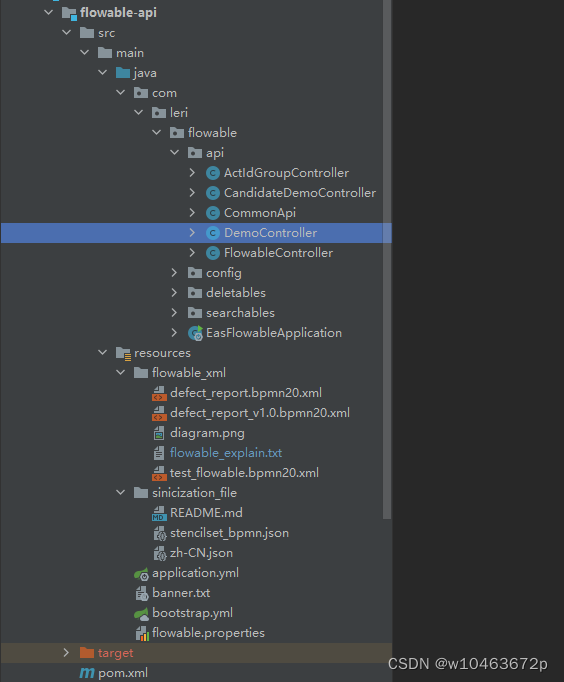
- 测试需要的流程图
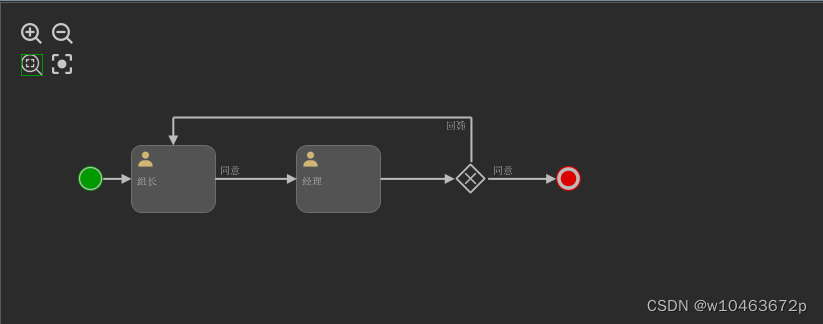
三.flowable项目正确开发使用流程
1.首先正确配置flowable.properties该文件,默认在启动项目时会生成34张工作流数据表(均已ACT_开头)
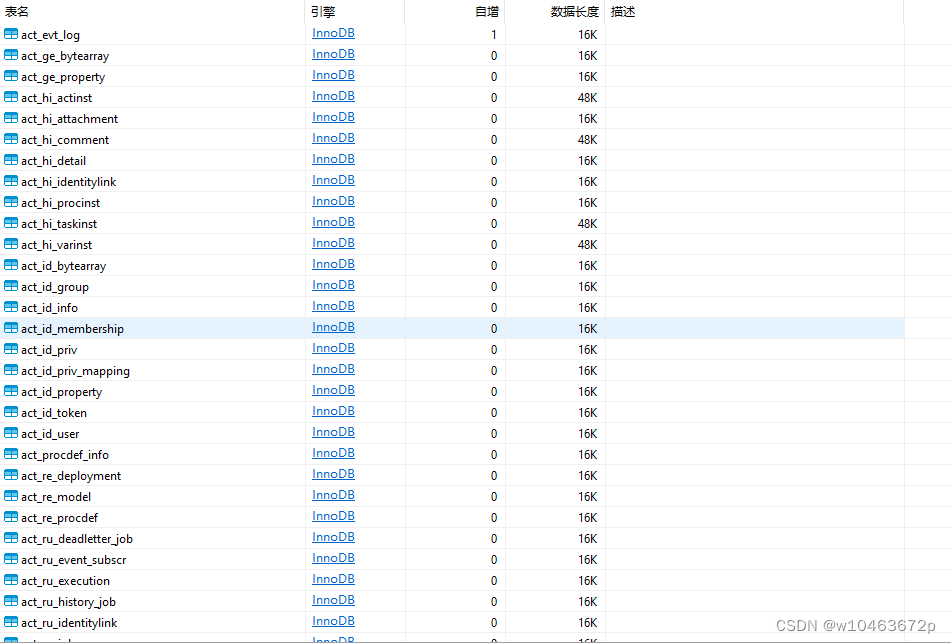
2.利用tomcat启动flowable-admin.war,然后用flowable-ui创建对应的bpm文件(或者其他的bpm工具)
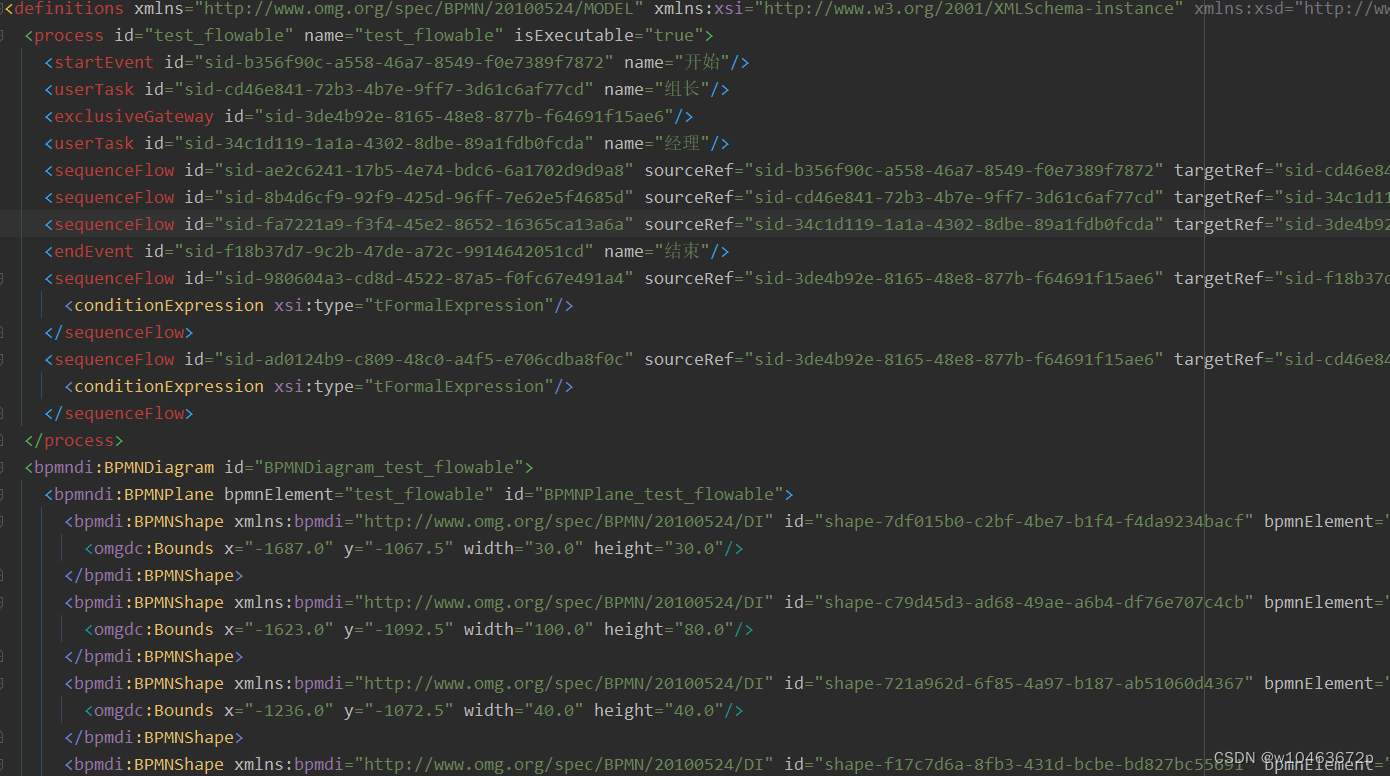
3.调用/deployment这个接口,部署已经写好的流程实例,参数参照后台方法说明传递即可
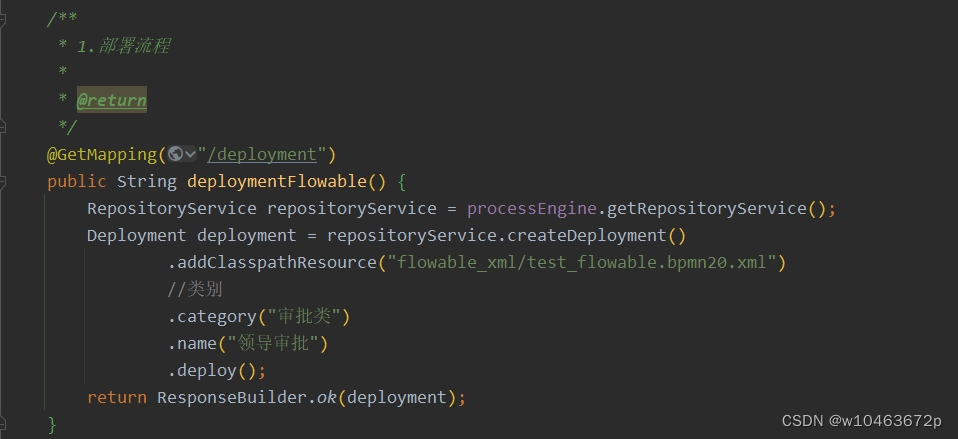
4.分别查看act_re_deployment,act_re_procdef和act_ge_bytearray数据表,如果生成了相关数据即代表部署成功

5.最后就可以在相关模块创建任务开始动态执行流程
四.flowable流程业务实现以及部分关键代码展示
以下关键代码,需要特意说明的是:
ProcessEngine是flowable提供对公开BPM和工作流操作的所有服务的访问关键对象。
FlowProcessDiagramGenerator是flowable生成流程实例图片的关键,继承自
org.flowable.image.impl.DefaultProcessDiagramGenerator类
1.流程部署
/**
* 1.部署流程
*
* @return
*/
@GetMapping("/deployment")
public String deploymentFlowable() {
RepositoryService repositoryService = processEngine.getRepositoryService();
Deployment deployment = repositoryService.createDeployment()
.addClasspathResource("flowable_xml/test_flowable.bpmn20.xml")
//类别
.category("审批类")
.name("领导审批")
.deploy();
return ResponseResult.ok(deployment);
}2. 查询流程定义
/**
* 2.查询流程定义
*
* @return
*/
@GetMapping("/queryDeployment")
public String queryFlowableDeploy() {
RepositoryService repositoryService = processEngine.getRepositoryService();
//查询所有定义的流程
List<ProcessDefinition> list = repositoryService.createProcessDefinitionQuery().list();
//查询单个定义的流程
/*ProcessDefinition processDefinition = repositoryService.createProcessDefinitionQuery()
.deploymentId("5")
.singleResult();*/
// System.out.println("Found process definition : " + processDefinition.getName());
return ResponseResult.ok(list);
}3.启动流程实例
/**
* 3.启动流程实例
*
* @return
*/
@RequestMapping("/start/instance")
public String startProcessInstance() {
RuntimeService runtimeService = processEngine.getRuntimeService();
//要启动流程实例,需要提供一些初始化流程变量,自定义
Map<String, Object> variables = new HashMap<String, Object>(0);
variables.put("employee", "工作组");
variables.put("nrOfHolidays", 8);
variables.put("description", "请假");
ProcessInstance processInstance =
runtimeService.startProcessInstanceByKey("leader_approval_key", variables);
return ResponseResult.ok(processInstance.getName());
}4.通过流程执行人员查询任务和流程变量
/**
* 通过流程人员定义查询任务和流程变量
*
* @return
*/
@RequestMapping("/query/task")
public String queryProcessInstance() {
TaskService taskService = processEngine.getTaskService();
//通过组查询任务表
// List<Task> tasks = taskService.createTaskQuery().taskCandidateGroup("managers").list();
//通过人查询单个任务
Task task = taskService.createTaskQuery().taskAssignee("小王").singleResult();
//通过任务id查询流程变量
Map<String, Object> processVariables = taskService.getVariables(task.getId());
return ResponseResult.ok(processVariables);
}5.通过任务id完成任务
/**
* 通过任务id完成任务
*
* @return
*/
@RequestMapping("/complete/task")
public String completeTask(String taskId) {
TaskService taskService = processEngine.getTaskService();
//领导审批提交的表达信息
Map<String, Object> variables = new HashMap<String, Object>(0);
taskService.complete(taskId, variables);
return ResponseResult.ok();
}6.通过流程执行人或者审批人查询审批历史记录
/**
* 通过审批人获取历史任务数据
*
* @param name
* @return
*/
@RequestMapping("/history/task")
public String getHistoryTask(@RequestParam("name") String name) {
HistoryService historyService = processEngine.getHistoryService();
//历史任务流程——流程id
List<HistoricActivityInstance> activities =
historyService.createHistoricActivityInstanceQuery()
.processInstanceId("2501")
.finished()
.orderByHistoricActivityInstanceEndTime().asc()
.list();
//历史任务
List<HistoricTaskInstance> list = historyService.createHistoricTaskInstanceQuery().taskAssignee(name).list();
return ResponseResult.ok(list.toString());
}7.通过流程id查询流程执行图(多种获取方式)
/**
* 通过流程id获取流程资源
*
* @return
*/
@RequestMapping("/process/resource")
public void getProcessResource(HttpServletResponse response) throws IOException {
RepositoryService repositoryService = processEngine.getRepositoryService();
/*ProcessDefinition processDefinition = repositoryService.createProcessDefinitionQuery()
.deploymentId("5085")
.processDefinitionId("defect_report_flowable:1:5088")
// .processDefinitionKey("leader_approval_key")
// .deploymentId("5")
.singleResult();*/
BpmnModel bpmnModel = repositoryService.getBpmnModel("defect_report_flowable:1:4");
InputStream imageStream = processDiagramGenerator.generateDiagram(bpmnModel);
/*String diagramResourceName = processDefinition.getDiagramResourceName();
InputStream imageStream = repositoryService.getResourceAsStream(
processDefinition.getDeploymentId(), diagramResourceName);*/
FileOutputStream fos = new FileOutputStream("D:\\data\\22222.png");
byte[] b = new byte[1024];
int leng = -1;
while ((leng = imageStream.read(b)) != -1) {
fos.write(b, 0, leng);
}
fos.flush();
imageStream.close();
fos.close();
/*
//文件流直接写出
ByteArrayOutputStream baos = new ByteArrayOutputStream();
OutputStream os = response.getOutputStream();
int ch = 0;
while (-1 != (ch = imageStream.read())) {
baos.write(ch);
}
os.write(baos.toByteArray());
imageStream.close();
baos.close();
os.close();*/
}五.其他相关的功能和问题持续更新,有问题私信
1.生成流程实例图片的关键代码
@Service
public class FlowProcessDiagramGenerator extends DefaultProcessDiagramGenerator {
private static final String IMAGE_TYPE = "png";
@Value("${flowable.activityFontName}")
private String activityFontName;
@Value("${flowable.labelFontName}")
private String labelFontName;
@Value("${flowable.annotationFontName}")
private String annotationFontName;
@Value("${flowable.xml.encoding}")
private String encoding;
@Autowired
private ProcessEngine processEngine;
/**
* 生成执行动态图片流
*
* @param processDefinitionId 流程定义的id——xml文件规固定的key
* @param businessKey
* @return
*/
public InputStream generateActiveDiagram(String processDefinitionId, String businessKey) {
RuntimeService runtimeService = processEngine.getRuntimeService();
HistoryService historyService = processEngine.getHistoryService();
RepositoryService repositoryService = processEngine.getRepositoryService();
//1.获取当前的流程定义
ProcessInstance processInstance = runtimeService.createProcessInstanceQuery()
.processDefinitionId(processDefinitionId)
// .processInstanceId(processInstanceId)
.processInstanceBusinessKey(businessKey)
.singleResult();
//流程实例执行的实例id
String processId = null;
List<String> activeActivityIds = new ArrayList<>();
List<String> highLightedFlows = new ArrayList<>();
//3. 获取流程定义id和高亮的节点id
if (processInstance != null) {
//3.1. 正在运行的流程实例
processId = processInstance.getProcessInstanceId();
//2.获取所有的历史轨迹线对象
List<HistoricActivityInstance> historicSquenceFlows = historyService.createHistoricActivityInstanceQuery()
// .processDefinitionId(processInstanceId)
.processInstanceId(processId)
.activityType(BpmnXMLConstants.ELEMENT_SEQUENCE_FLOW)
.list();
historicSquenceFlows.forEach(historicActivityInstance -> highLightedFlows.add(historicActivityInstance.getActivityId()));
activeActivityIds = runtimeService.getActiveActivityIds(processId);
} else {
//3.2. 已经结束的流程实例
HistoricProcessInstance historicProcessInstance = historyService.createHistoricProcessInstanceQuery()
.processDefinitionId(processDefinitionId)
// .processInstanceId(processId)
.processInstanceBusinessKey(businessKey)
.singleResult();
if(historicProcessInstance == null){
throw new MessageCodeException(MessageCode.FLOWABLE_PROCESS_IS_RELEASE_SUCCESS);
}
processId = historicProcessInstance.getId();
//3.3. 获取结束节点列表
List<HistoricActivityInstance> historicEnds = historyService.createHistoricActivityInstanceQuery()
.processInstanceId(processId)
.activityType(BpmnXMLConstants.ELEMENT_EVENT_END).list();
List<String> finalActiveActivityIds = activeActivityIds;
historicEnds.forEach(historicActivityInstance -> finalActiveActivityIds.add(historicActivityInstance.getActivityId()));
}
//4. 获取bpmnModel对象
BpmnModel bpmnModel = repositoryService.getBpmnModel(processDefinitionId);
//模型 活动节点 高亮线
return generateDiagram(bpmnModel, IMAGE_TYPE, activeActivityIds,
highLightedFlows, activityFontName, labelFontName, annotationFontName,
null, 1.0);
}
/**
* 生成工作流程图
*
* @param bpmnModel 模型
* @return
*/
public InputStream generateDiagram(BpmnModel bpmnModel) {
return generateDiagram(bpmnModel, IMAGE_TYPE, activityFontName,
labelFontName, annotationFontName,
null, 1.0);
}